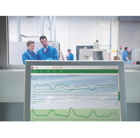How metering and monitoring boost energy efficiency

Regulations that require the detailed monitoring of energy consumption in buildings can drive energy-saving changes in practices and behaviours. Poonam Walid of Schneider Electric shares her experience.
Buildings are responsible for 40% of global energy use and contribute 30% of total global CO2 emissions. By 2030, electricity consumption will have grown by more than 70% compared to current levels. There’s a push by both Government and businesses right now towards creating a more sustainable and low-carbon economy in the UK — one that generates fewer greenhouse gases and increases efficiency. For this reason, buildings have a huge role to play in helping the UK meet its 2050 Climate Change Act targets.
Advanced metering and monitoring solutions are vital for enabling data-driven energy efficiency. Landlords and commercial building managers are becoming increasingly aware of power-monitoring solutions as a way of gaining a detailed view of their energy use. This insight in turn supports energy efficiency and cost-reduction efforts.
Effective metering and monitoring gives owners and operators crucial information about how their buildings are performing. This can deliver substantial, almost-immediate improvements.
Energy metering can help with identifying cost cutting opportunities by detecting inefficiencies, benchmarking building performance, improving load planning and energy usage and managing demand to ensure there is minimum exposure to volatility.
An effective metering and monitoring system is one with the capacity to get tenants, property managers, and owners involved in energy-efficiency measures. The ability to identify and quantify energy use is often sufficient to bring about energy-saving changes in practices and behaviours, such as reducing waste and avoiding peak utility rate periods when possible.
For example, Schneider Electric has been working with Oxford University for the past 20 years to install main meters and sub-meters in all the university buildings. There are over a thousand meters in total, which are designed for key distribution points and sensitive loads to offer advanced power quality and billing accuracy. On top of this, Oxford University uses Schneider Electric’s Power Monitoring Expert solution to help organise and analyse metering data for reducing energy costs and increase efficiency.
Another factor driving greater energy efficiency is the increase in energy-related building legislation globally, as well as locally in the UK and EU. These legislative and regulative changes are acting as a motivator for increased levels of metering, sub-metering and control solutions. This is across all buildings, but mostly commercial buildings where there are the most savings to be gleaned. One example is the European Energy Performance of Buildings Directive (EPBD), which requires all EU member states to encourage intelligent metering and control systems in new or renovated buildings.
A wealth of energy-efficiency legislation has been implemented in the past decade to help reduce greenhouse-gas emissions. Some legislation has specific requirements regarding metering of buildings to increase efficiency. Others indirectly encourage building owners and managers to use metering as part of an overall strategy to reduce emissions.
Across Europe, legislation has been introduced in response to EU directives. These include the Energy Performance of Buildings Directive (EPBD 2002 and 2010) and the Energy Efficiency Directive (2012). EPBD 2002 introduced building energy labelling and encouraged the installation of smart meters and sub-meters. The EPBD 2010 included specific requirements for data collection via meters and controls to accurately calculate DEC (Display Energy Certificate) rating. The Energy Efficiency Directive required the provision of smart meters to all customers and the creation of energy audits for businesses.
Sub-metering and control requirements are included in the Building Regulations Part L. It covers both new buildings and retrofits. For new buildings, the regulations focus on the fact that end-use categories (like heating and lighting) must be assigned to 90% of building energy use. Any renewable energy systems must also have their output monitored. Buildings over 1000 m2 must have automatic meter reading and data-collection systems installed.

The Energy Savings Opportunities Scheme (ESOS) is a mandatory energy-assessment scheme. It requires large UK companies to conduct regular energy audits. Companies employing over 250 people, or having an annual turnover in excess of £50 million are included in the scope of ESOS. The scheme administrator is The Environment Agency. A sample of assessments are audited every four years. The next ESOS assessment audit is due on 5 December, 2019.
It’s not just building legislation that is driving an increase in the installation of metering and monitoring solutions. The Building Research Establishment Environmental Assessment Method (BREEAM) is the world’s longest-established method of assessing, rating and certifying the sustainability and energy efficiency of buildings. More than half a million buildings globally have been BREEAM certified, and over two million are registered for certification.
From a metering perspective, BREAAM’s aim is to recognise and encourage the installation of sub-metering that facilitates the monitoring of operational energy consumption.
Research carried out by construction consultants Sweett Group and BRE found that developers typically invest up to 2% more when targeting higher BREEAM ratings. Furthermore, they recover that additional investment in two to five years through savings in energy and water bills.
Research also found that BREEAM office buildings in London achieve a 21% premium on transaction rates and an 18% premium on rent. Therefore, the initial investment in a certified metering and monitoring system pays for itself and starts to provide further benefits in a very short timeframe.
As the nation progresses towards a brighter and more sustainable future, energy visibility is paramount for optimised efficiency. With this in mind, we’re expecting further regulations and legislation in line with that already in place. While more businesses are already thinking in a more-energy-efficient way, regulation helps push those dragging their heels toward better building efficiency. It’s not just the regulation, but also advances being made in metering, which are paving the way for businesses to gain greater insight into their energy use and make informed commercial decisions. More and more metering and monitoring packages are being sold — not just the implementation of a metering system, but also the installation of software. Together, this is technology that collects and organises data gathered from any building’s electrical network and presents it as meaningful and actionable data.
The UK Government is committed to reducing carbon emissions by 80% by 2050. Within that figure, 40% of the UK’s energy consumption and carbon emissions are coming from the way our buildings are lit, heated and occupied. This means that whilst legislation and regulation is already pushing some companies and facilities managers towards installing more-robust power-monitoring systems, buildings still need to be doing more — whether that’s through re-fit, expansion, or making sure energy efficiency is front of mind when completing a retrofit or building a new commercial building in the UK.
Poonam Walid is category marketing manager for power monitoring at Schneider Electric.







